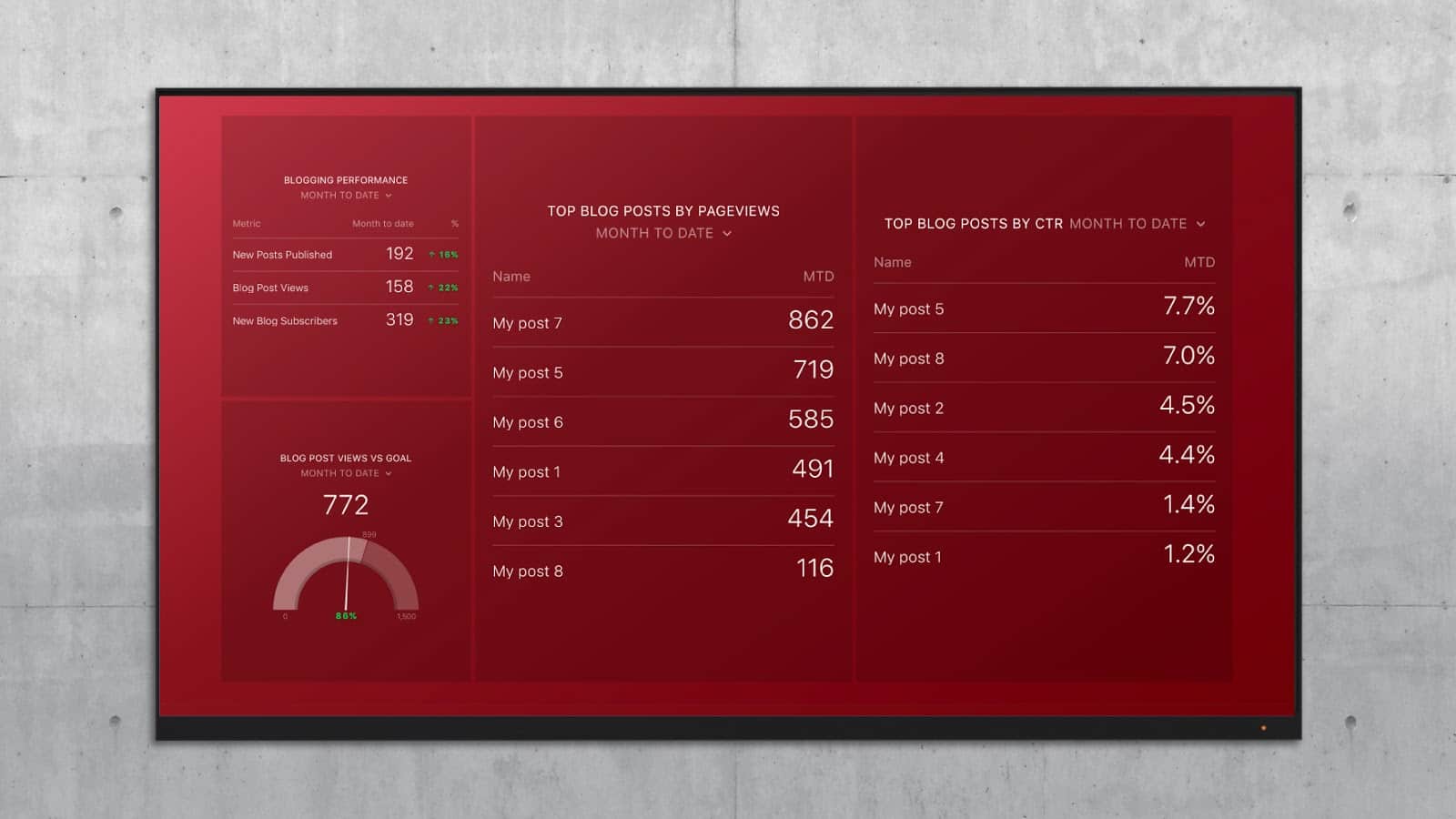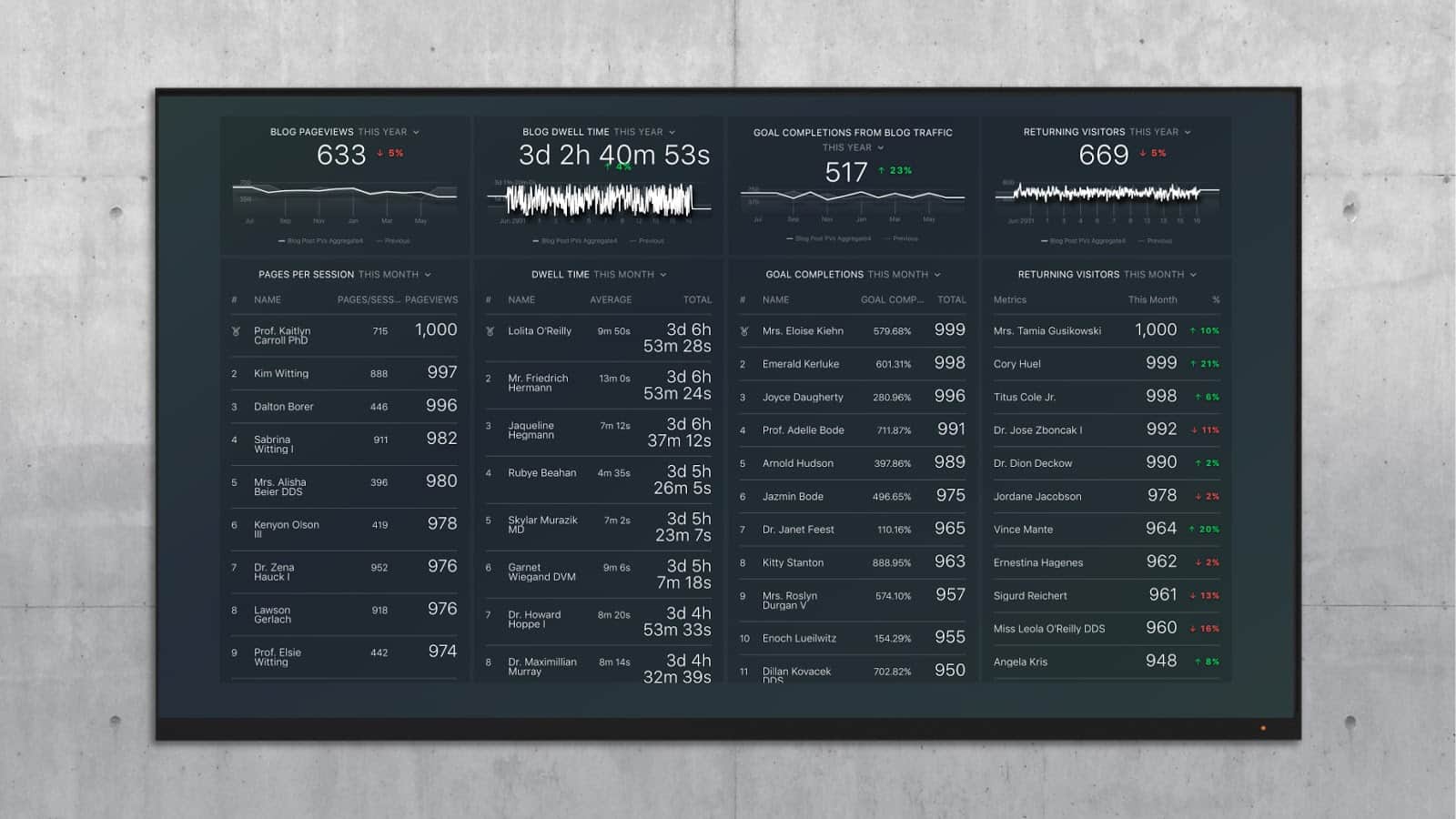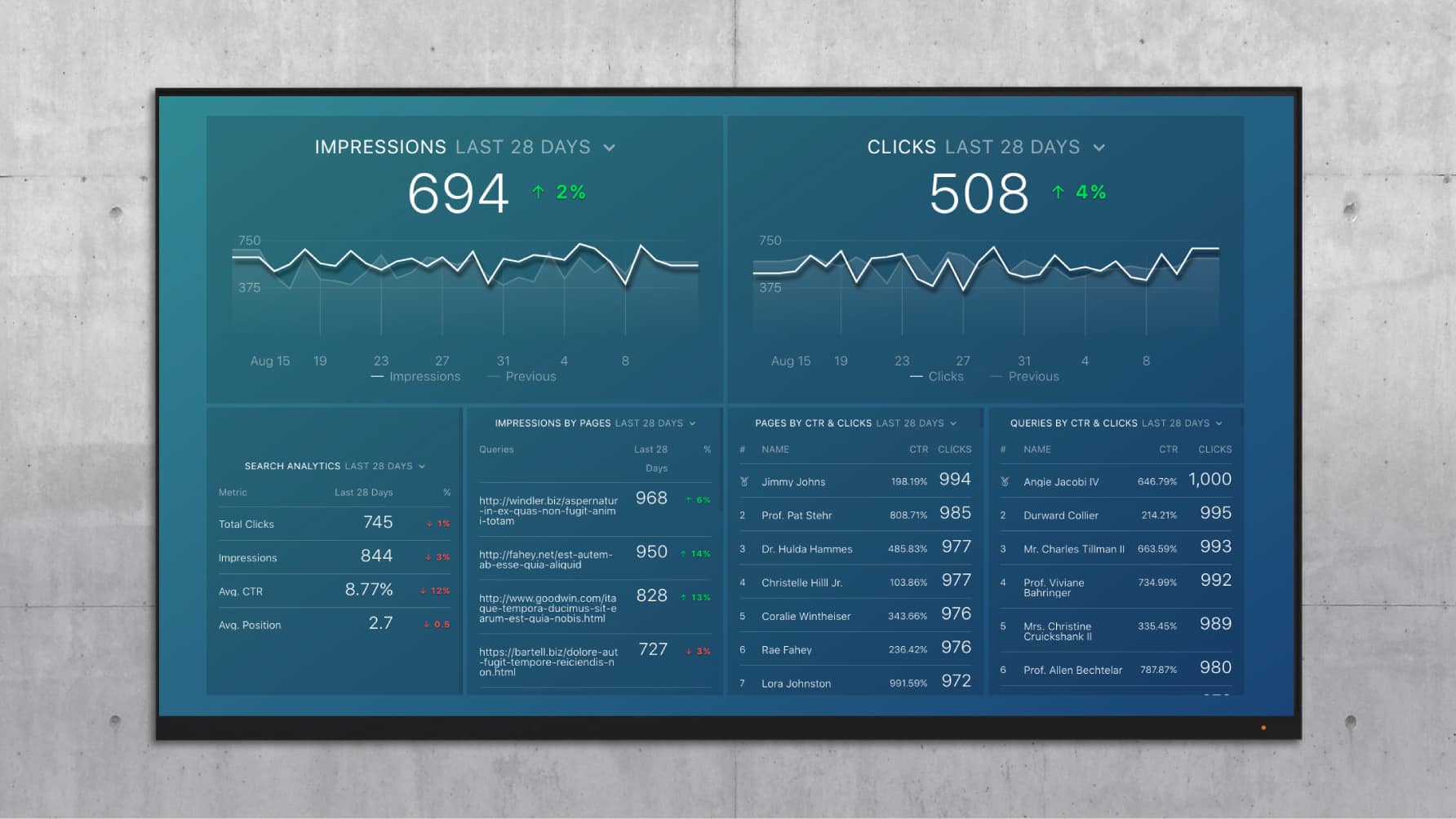Table of contents
Have you ever felt that business blogging just wasn’t worth the effort?
Have you caught yourself saying things like, “Decision-makers in my industry don’t seem to read blogs” or “My posts never achieve a high ranking on Google. It’s so competitive.”
Don’t give up hope yet.
In reality, business blogging is a pretty complicated process. There are a lot of things you have to get right. It’s not as simple as just answering common questions from your customers. Although that’s a good start, you also need to consider search engine optimization principles, content promotion and blog design too.
To compile best practices, we asked well-known bloggers like Andy Crestodina from Orbit Media, Sean Si from SEO Hacker and Muthoni Wambugu from Authoritative Blogging as well as experts from multi-million dollar marketing agencies like Kathleen Booth from IMPACT, Sandie Young from PR2020 and Jessica Janda from Weidert Group — to share one tip they’ve employed that’s gotten results for them and their clients. Their wide range of responses reiterated the large number of factors that influence a blog’s success.
So, if you are unsatisfied with the ROI of your blog, read through and try some of the tactics below to improve your performance. Keep in mind, that while many of these suggestions will grow your leads over time, they are not instant solutions!
Company Blogging Tips
- Crowdsource Content From Your Audience
- Create A Mission
- Create Long-Form Content
- Follow SEO Best Practices
- Improve Call-to-Actions (CTAs)
- Improve the Design of Your Blog
- Create A Promotion Plan

Crowdsource Content From Your Audience
One of the best ways to add social proof to you brand is to amplify the voices of your customers. But, you also need to consider what is in their best interest. Sure, you can ask for a review or testimonial once in awhile, but there are other ways to feature your customers by putting THEM at the center of the story, instead of your brand.

Lorraine Reguly
Wording Well
One Blogging Tip: Company blogs that feature a page of client testimonials tend to generate more business than companies that don’t.
Client testimonials are powerful. They show others the traits the company has.
Client testimonials act as social proof – proof that you are who you claim to be, proof that you are trustworthy and honest, and proof that you can deliver what your client/customer wants.
If you are just starting out and your business is new, don’t fret! You can still obtain testimonials about the product(s) and/or service(s) your business offers!
You can use testimonials in a variety of places:
- on your website
- in emails
- in your newsletters
- in brochures and/or flyers
- on sales pages
- in newspaper and/or magazine advertisements
- in postcards
- in videos
- in podcasts

Pete Caputa
Databox
One Blogging Tip: Most companies write content for their audience. We write our content with our audience.
Among other things, we do roundup posts where we ask experts to answer one question. Then, we compile all their answers into one post. 800+ people have contributed to our posts in the last year.

Georgi Todorov
Digital Novas
One Blogging Tip: Invite influencers and famous bloggers for a roundup post on the company’s blog. It brings many benefits.
First of all, you have the chance to establish a relationship with those people. Second, once the roundup post is published, the influencers will share it with their audience. The post will get a massive exposure to people who might be interested in your product or service. Third, it brings a peak in traffic for a few days. Fourth, the post may rank well in Google and brings you traffic in the long run.

Mike Allton
The Social Media Hat
One Blogging Tip: One of the most effective techniques I’ve used is a Roundup post. Rather than create an article sharing my own opinions, I come with a compelling question and post it to brilliant experts in my field. I can then publish all of their submitted answers collectively, just like this post you’re reading now.
The thing is, to be successful, a roundup must have two elements:
1. A very compelling question. This is harder than you might think because the question needs to be compelling, not just to readers, but to the experts you pose it to. A boring question will see far fewer responses from experts.
2. The right mix of niche experts and mainstream influencers. While it’s true virtually everyone is an influencer, it also cannot be denied that some people have *more* influence than others. In order for your roundup to be a success, it needs to have great content in the form of the answers, but it also needs to include opinions from experts with larger audiences than you.
Once compiled and published, you can then mention & tag all of the participating experts and leverage their wider audience.

Create A Mission BESIDES Growing Traffic Or Promoting Your Brand
Yes, everyone needs to increase the traffic to their blog in order to hit their goals. But, if you make traffic your only goal, you will quickly lose sight of the problems that you are solving for your customers. You might still get traffic, but you will have a hard time converting that traffic into customers.
Hopefully, it goes without saying at this point that you can’t use your blog strictly for self-promotion. That shows little attention to the customer’s problems.
PRO TIP: Measure Your Content Marketing Performance Like a Pro
Struggling to track the impact of your content across platforms? We feel you. Thanks to Databox, fragmented data doesn’t have to hold you back anymore.
Our library of free content marketing dashboard templates puts all the insights and metrics you need in one place. No more jumping between reports!
Measure engagement: Track key metrics like likes, comments, shares across social media platforms to see what content resonates most with your audience. Analyze website traffic, bounce rate, and average time on page to understand how visitors interact with your content.
Optimize conversions: Identify high-performing landing pages and blog posts that drive the most leads using dashboards like HubSpot Marketing Lead Source. Analyze campaign performance and user activity for both organic and paid content with a Facebook Pages & Facebook Ads dashboard.
Improve SEO: See which pages rank highest in search results and drive the most organic traffic. Improve search visibility by visualizing key SEO factors like backlinks and domain rank.
You can easily set it up in just a few clicks – no coding required.
To set up a dashboard, follow these 3 simple steps:
Step 1: Choose a fitting template
Step 2: Connect your data
Step 3: Watch your dashboard populate in seconds

Sean Henri
Pepperland Marketing
One Blogging Tip: Avoid the temptation to create clickbait-y fluff that gets a lot of traffic but very few qualified leads. A blog post that generates ten visits from ten people who have a major pain point that your company can solve is far more valuable than a blog post that generates ten thousand visits from people who will never buy from you.

Rob Steffens
Bluleadz
One Blogging Tip: The best tip I can give to increase your blog’s performance is to address your persona’s pains. You should constantly be providing value to your readership, and what better way than answering the questions they have? Writing to the pains of your audience, and having a recommended solution to those pains is the way to go. This has been a terrific strategy for us, and our clients that have provided some considerable results.

Sandie Young
PR 20/20
One Blogging Tip: Revisit your blog’s mission.
With the pressure to post as frequently as possible, it’s easy to fall into haphazard publishing habits. But, this can be more detrimental to your blog’s long-term value than you think. Your readership (and prospective readership) expects a certain level of quality with topical relevance. Revisit your blog’s mission statement, and explore whether your team can answer the question: “What problem are we solving for our readers?”
Every blog post should play a role in achieving that overarching mission. Once you create a strategic roadmap for current and future content topics, you’re more likely to attract the right readers—and keep them coming back.
Track your HubSpot blogging metrics by post in real-time with the HubSpot Blog Performance dashboard. Don’t use HubSpot? Monitor the success of each post sorted by author and publish date with this blog post dashboard.


Rai-mon Nemar Barnes
CodeSwitch Marketing
One Blogging Tip: The first tip we always give clients at CodeSwitch is the following tip that involves getting in touch with the artist side of the brand.
Creators know they have an obligation to deliver on their promise to their audience. The promise is, of course, up to them, not their audience, just like your promise is up to you, not your customers, but your content needs to have a focus on this promise.
One way to come up with a promise is to look at past testimonials and find a common thread. Something most of your clients or customers feel you deliver upon consistently. Then make your content an extension of that. If your audience / clients feel you are insightful and knowledgeable, then make sure to deliver insights, not data, in all of your content. While we’re on the word content…..
Too many businesses are into creating “content” and not moments or interactions that are helpful and entertaining. Blog posts and the like are a chance to show some personality and not bare the bad consequences that may come with too much personality in business transactions.

Tim Stobierski
Pepperland Marketing
One Blogging Tip: I think one of the single most helpful things that every company should do is create an editorial mission statement for their company blog.
Doing so accomplishes a number of things:
- It helps your reader know, quickly, whether or not your website will potentially answer their question
- It offers something for your marketers and content creators to reflect back on as they’re creating content, to ensure that it is content that is relevant to your buyer personas and business in general.

Chris Lee
RankXL
One Blogging Tip: Most companies get blogging all wrong. They’ll read a few articles about how important content marketing is, and then they’ll throw up thin, generic blog posts every week that don’t do anything.
They won’t generate any links, shares, or leads.
One of the best things a company blog can do is feature stories/updates about what they’re doing. It may not be content that directly targets their potential customer, but it’s great for generating links and shares from other businesses and bloggers.

Greg Moore
JustBats.com
One Blogging Tip: Starting in early 2017, we opted to take a thought leadership approach to our blog. So, instead of writing a baseball bat review or doing a Q&A with an industry person, we started writing blog posts that answered questions. For example, “What is BBCOR?” and “7 Best 2018 Fastpitch Bats”.
The results were incredible. Not only were we answering customer questions and providing genuine answers, we started to own and rank for keywords we never had. Our blog visits increased 290% year-over-year from 2016-2017, and it’s on pace to do the same for 2018.

Alex Swallow
The Influence Expert
One Blogging Tip: The most important tip for me is that you need to always think of your audience.
This might seem simple (who else are you writing for?) but it is easily forgotten.
There are three key ways in which you need to think about your audience:
1- What level are they at?
You need to think about what your key audience already knows. Let’s say that you and your team have built up expertise in a particular area and now you want to share it with your audience. What stage is your audience at? Are many of them nearly as skilled as you in this area? Or are most of them beginners? This will really make a difference to what- and how- you write.
2- What are their biggest concerns?
In order to connect with your audience, you need to think about what are the things they really worry about. How can you teach them some things that will take away some of that worry? What are the steps you will need to take them through for them to feel that they have really made progress?
3- What is the best way to teach them?
How does your audience like to learn? What sort of articles grab them? Do they enjoy discussion articles, ‘how to’ articles, interviews, guest posts? Also, how can you write for them in an engaging, personable manner? For this latter point, one great tip is to think of your ideal customer or ‘avatar’ and then produce content as if you are writing directly to them.
If you think about your audience and consider these three key things, you will get more blog views, more engagement and build a stronger community around your work.

Sam Smith
Laire Group Marketing
One Blogging Tip: Plan ahead and develop a content calendar.
Auditing your existing content will give you a clear view of the overall health of your blog.
You should be looking at what’s been covered and how those pieces stack up against your ideal personas and the stages of the buyer’s journey. For example, when auditing a new client we found they were only writing about one service for one persona.
Find and fill those gaps. A content plan will make sure all of your content reaches your entire audience without leaving anyone out.
We’ve seen this be impactful for us and our clients. A monthly content check-in is all you need to make sure your delivering helpful content to your visitors.

Jennifer Schulman
Fortune Web Marketing
One Blogging Tip: Humanize it! Don’t just look at the B2B or B2C marketing factor, look at the Person-to-Person (P2P) aspect of marketing. Of course you want to establish yourself as a subject matter expert, but people want to engage with the human aspect of your business as well. So humanize your brand, by humanizing your brand and the content on your blog. Relate to your customers and prospects by engaging them on a more personal level. Combine that with posts that speak toward your expertise, or promote products and services that you provide.

Martin Woods
Indigoextra Ltd
One Blogging Tip: Write blog posts with a range of different audiences in mind:
- Potential clients
- Visitors seeking information only
- Your own company
For small to medium businesses, most visitors won’t be familiar with your company when they visit your blog and are therefore more likely to be looking for solutions to a problem than asking “which product should I buy?” Unless you’re announcing an event, new product line, or something else newsworthy, I therefore recommend making the first half of the blog entirely informative and beneficial to your reader. You can then include links to product pages and some promotional information in the second half of your blog.
To help with Google rankings, do some keyword research first and look up phrases that contain ‘how’, ‘what’, ‘when’, etc. Let’s say you sell water purifiers, 74,000 people a month in the US search in Google for the exact phrase, “How much water should you drink a day.” Find a phrase that is relevant to your company’s product that people actually search for as the topic for your blog entries.
Google also increases the ranking of pages where people spend more time, another reason to make blogs truly useful to all your potential readers.

Kim Scaravelli
Trust Communications Inc.
One Blogging Tip: Consider making your post “Evergreen”.
The term “evergreen” refers to content that remains fresh and relevant to readers over the long haul. In contrast, time-sensitive content may create an immediate buzz but its life span is short. For example, a post titled “5 Ways to Be a Better Manager in 2015” might do well in January of 2015, but an evergreen post titled “How to Be a Better Manager” would be perpetually relevant.
When it comes to evergreen versus time-sensitive content, it is not an Either-Or situation. You need to create both timely and timeless pieces. The important thing is to make the choice BEFORE you start writing.

Adam Connell
Blogging Wizard
One Blogging Tip: When it comes to growing an audience, most companies prioritize what they want to share over what their audience wants to learn.
While it’s worth sharing company news and announcements, there is a lot of room for reader focused, useful content.
Here’s an example of how well this can work:
A while back, a real estate agency client came to me with this exact problem.
To solve this, we created a content calendar focused on what their ideal customer would want to learn. And we mapped this content to their buyer journey.
Within a few months, their traffic had tripled and rankings across their most profitable keywords had skyrocketed. And this was without working on link acquisition or any sort of paid promotion.
Taylor Jaco
Webfitters
One Blogging Tip: Honestly, it comes down to how valuable the blog is to the individual reading it.
While there are a number of ways you can go about constructing a blog, all that matters at the end of the day is what the reader walks away with. For our digital marketing blog, rather than just talk high-level strategy, I started telling my readers exactly what to do regarding their social media marketing efforts. Walking someone through how to set up their first Facebook campaign is way more valuable to them than me rambling on about the benefits of Facebook marketing.

Muthoni Wambugu
Authoritative Blogging
One Blogging Tip: Where most people stumble is focusing so much on what your competitors are doing and the type of content they are creating rather than focusing on what your end goal is.
What is the main objective for creating this type of content?
How does it benefit your company in the long term?
These are the questions you need to be asking yourself as you are coming up with a content plan.
So, let’s say your goal is to sign more clients for your advertising agency. Don’t focus on listing the best ads created in 2018 for the Super Bowl halftime (all the big brands like time, vogue, harper carry will cover that content).
Focus on articles such as “Qualities to look for in a good advertising agency” or “How x brand/client built a $1000/month income-generating Facebook ad funnel after failing countless times.”
These articles may get less traffic than buzz-fueled articles would.
That said, you will get more targeted leads who you could easily convert into buyers than you would have if you created a buzz-generating article.

John Mark Adkison
Thoma Thoma
One Blogging Tip: Try giving your blog’s topic a unique spin — even if it seems crazy.
There are a whole lot of blogs out there and, chances are, what you’re writing about, a hundred other writers have already written about. That’s where giving your blog topics a unique and unexpected spin can not only help improve your clicks, but keep them coming back. But in order to do that, you need to think outside the box and inject a great deal of creativity.
Here’s an example of what I mean: In 2017, everyone was nabbing up voice search “personal assistants” such as the Amazon Echo and Google Home as quickly as possible. We wanted to write a blog about how voice search is impacting marketing and how to begin optimizing websites for voice search. But of course, there were dozens of blog posts out there already on the subject.
So we decided to go at the topic from another angle — disembodied voices. The blog post came up around Halloween time, allowing us the opportunity to write a clever title and introduction, focusing on the “disembodied voice/magical/ghostly” aspect of voice search. It wasn’t a bland or dull approach — instead, it allowed for some creativity, fun and more interesting content matter.
Now remember: Your posts should always be clear, informative and easy to read, but they don’t have to have the straightforward title of “How to do X”. Look for current trends, pop culture references and upcoming events you can tie your content in with to help make it more appealing and engaging.

Create Long-Form Content
5-7 years ago, there were so few active blogs that you could write a 500-750 word post on a B2B topic, and expect it to rank well within a few months. Now, with the growth of inbound and content marketing, you must spend more time on building authoritative posts over 1500 words in length. This is not a hard rule, but more of a general guideline to help you set the correct expectations.
If you only create short content, you will struggle with most keywords, no matter the industry.

Michael Rand
Market Veep
One Blogging Tip: We prioritized long-form content.
Not to wade too far into the long vs. short debate, but we’ve seen a lot more organic traffic since we started writing blog posts that are at least 1500 words or even up to 2500+ words. We used to write 500-700 words max on each post and our organic traffic was at a trickle. There’s some context to this, however.
Short content is great because it can hold people’s attention long enough for them to get the point. It’s usually sold as “highly shareable,” especially if it’s accompanied by cool images or video. It’s not a bad idea if you, or multiple people, update your blog every day. We think it’s an okay strategy for B2C businesses who need a lot of content for social.
But short content doesn’t really work for our target buyers.
As an agency, we’re a B2B business. Our customers’ buying cycle is longer. Most of our customers do a lot of research before they commit to a marketing agency. We also serve a lot of clients that don’t have internal marketing staff, so they may not know much about inbound marketing, digital marketing, or marketing in general. We can’t update our blog as often as we’d like, so we prioritize long, high-value articles each month.
Long-form content gives us an opportunity to demonstrate our depth of knowledge on important subjects. We know that most people won’t be reading our posts in their entirety, but we at least want to show we know what we’re talking about.
From an SEO standpoint, we know that Google penalizes websites with “thin” content (According to Yoast: Less than 300 words). Long-form content tends to rank very well. It also earns more backlinks. Long-form pages are generally regarded as a valuable resource, especially if they’re built with a table of contents, links to valuable external and internal resources, or if they contain statistical information.
We don’t fill our long blog posts with fluff, either. If a topic isn’t worth writing 2000 words about, it doesn’t get 2000 words. The best topics are the ones where you’re enthusiastic to keep writing and writing, only to look down at your word count and see that you’ve blown past 2000 words without even trying.
We’re also starting to write pillar pages. Our shorter blog posts will link to them (if they’re relevant subtopics). These pages will be about 3000 to 7000 words long.
Long-form content takes much more time than your typical 500-word blog post. But we know the rewards are well worth it.

Alex Koby
Adhere Creative
One Blogging Tip: A simple and easy tip to improve your company blog is to refocus on a strategy that will separate you from the competition.
For example, we recently decided to move away from list blogs and tip-based blogging for a hyper-specific resource-based approach. By changing our strategy we will stand out from the crowd while providing specific value to our buyer personas.
Another way to separate from the crowd could be blog length. If your competition typically writes blogs around 500 words, maybe you change your blog strategy to only post 1-2 times per month, but each blog is 1500 words and dives deeper into the blog topics. These changes are easy to make and will help you cut through the clutter of the over-saturated blogosphere.
Track the posts that your visitors enjoy most with the Google Analytics Blog Quality dashboard


Chris Fell
g2m solutions
One Blogging Tip: Blogging is a hungry monster that needs constant feeding…but worth the price of grocery bill as it’s the number one way for generating quality leads.
The secret is to plan cleverly. Build your “big rock” pieces of awareness-stage content (such as an eBook/whitepaper) first. When planning the table of contents think about your blogging schedule. Can you see 7 or 8 chapters or sections that will make great stand-alone blogs? Weave in 4 or 5 curated blogs from other experts surrounding the same topic and you have your quarterly blogging campaign done!
Not only that, but the effort to produce the blog is greatly reduced as the concept and the thinking is already done for you. You just need to edit for the tone of voice and perhaps add in a couple of supporting paragraphs and links. Hungry monster fed…at least for a while.
Final tip: Your awareness stage “big rock” piece and associated blogs is almost NEVER about you, but about the goals and challenges of your target audience. This applies to your chosen keywords too. Focusing one eBook, 12 blogs and dozens of linked social posts around a core set of keywords that your target buyers are typing into Google is going to go a long way to ranking well. Focus is the key.

Anna Kaine
ESM Inbound
One Blogging Tip: Make your blog the correct length.
500 words is the absolute minimum.
Blogs with an average word count of between 1,140-1,285 words are ranked as the top content in Google.
Write well and don’t rush – if you write a blog in half an hour, chances are it’s not going to be very good and not going to result in any leads.
The average blog post takes 3 hours 16 minutes to write, but it it’s useful, engaging and educational content, this will result in valuable leads.
Longer, in-depth posts are 9 times more likely to generate leads than shorter ones. This is because, not only do they appear higher up in search engine results, but readers engage with and remember bloggers who dedicate themselves to writing valuable content.

Danny Florian
KIT Digital Marketing Agency
One Blogging Tip: Blogs can get a little boring so to stand out, we created the “Blook” which is a combination of a Blog + Book design. If the majority of your blog visitors are on desktop (B2B), this design will help increase engagement and subscribers!
The idea behind the “Blook” is to show an image relevant to the content on the right-hand side. As your visitors scroll down, the image on the left-hand side is replaced. This helps keep visitors engaged and reduces eye strain, especially when you have long content blogs.
You can see the “Blook” in action on our site, along with other cool features such as a reading progress bar and fixed footers with call-to-actions for social sharing.

Follow SEO Best Practices
There are so many common SEO mistakes that it can be easy to become overwhelmed by all the possible improvements. And, the rules change every 2-3 years as Google adjusts its algorithm. The good news is that many of the decisions that create the largest ROI are easy to implement, like adjusting keywords and creating internal links.

Nathan Bracy
Revenue River
One Blogging Tip: There are SO MANY WAYS to improve your business’ blog, but I’ve seen two things that make the most impact. Since our adoption of both of these practices, we’ve increased our blog traffic by nearly 50% over 2 years (from 21,041 visits in 2016 to 30,641 visits in 2017).
The first way to improve your company’s blog is to create topic clusters and 10x content pages (also known as pillar pages). Take your “gated” eBooks or guides and make them a core piece of your blogging efforts. Link back to these 10x content pages or pillar pages when appropriate so you can have more and more domain authority so that more people can find your content through organic search.
The second way is to go back and update your old articles. Historical blog optimization involves analyzing your blog data to find the posts that received the most views, CTA clicks and even converted the most contacts. With an understanding of the best-performing blog articles, you can make them even better.

Brittany Laeger
StoryTeller Media + Communications
One Blogging Tip: We’ve found great success in revisiting old blog posts that performed well for a time had low or declining traffic. By spending time adding new content or updating the post to be more relevant and timely, we’ve been able to see some major boosts in traffic and organic rank.

Jacob Ingram
Eastside Co.
One Blogging Tip: Focus your efforts on improving already successful blog content.
Content doesn’t exist in a time capsule. Even a piece evergreen of content will focus on a topic that will constantly develop and evolve regardless of that blog. For example, if you write an article about a particular industry, that industry is going to shift and grow on its own, making that blog irrelevant.
A lot of content professionals look at underperforming content, and compare it to content that is already performing well, thinking that all content has the potential to rank equally well in organic search and traffic. However, improving on content that already has a strong foundation has much greater potential to increase blog performance.
These stats are taken from the most popular piece of content from a particular blog that I optimized. People were still looking for this particular search term, but over time the associated keywords had changed and aligned with new innovations within the industry. Simply keeping up to date and optimizing for this shift meant that we could capture relevant readers that had been missing the content previously.
Don’t overlook content that is already successful. It would take far longer to see a percentage increase of this size by creating a new piece of content, or improving on a piece of content that was underperforming.
Track your SEO metrics for free with the Search Console basics dashboard


Dennis Seymour
SeriousMD
One Blogging Tip: Listicles still work when done right. In my startup, I sit in when it comes to arranging our content calendar. I normally just write about the latest updates but when it comes to topic generation, I have a number of go-to content archetypes.
The listicle is one that almost can’t fail because people just love them. So to give an example, a listicle I had made last year about the top medical schools in the Philippines is still sending a good chunk of traffic each month since it started ranking. It’s been consistently one of the top posts and since it’s evergreen, we’ll be updating it over time and building more content types inside it.
The best part? The majority of readers are future users of our app and if ever a current doctor is just Googling his/her school, then maybe they’ll see the post and perhaps become a user. Remember, listicles still work, just do it correctly.

Craig Wilson
Sticky Digital
One Blogging Tip: One of the biggest problems companies encounter when blogging is deciding what to write about. This often leads to uninspiring, non-strategic content that delivers little traffic or interest.
We recommend following a more strategic plan that helps you rank for relevant long-tail search terms, delivers increased qualified traffic to your website, and prompts conversion to your product, service or inquiry pages.
First, look at your business offerings and conduct long-tail keyword research to find the best search terms to pursue. These aren’t broad generic terms, they’re search terms which often address a user’s intent. Sometimes the intent behind any particular keyword is much more important than the keyword itself. Long-tail keywords that address the need of the searcher or solve a definite problem will most likely rank well on Google, compared to similar head keywords. Customers who type descriptive key phrases (long-tail) are generally more qualified than those who type head keywords. As a result, the conversion rates are higher for long-tail keywords as compared to head keywords. We call it “content with intent”.

Maddy Osman
The Blogsmith
One Blogging Tip: Don’t ever write a blog post just for the sake of posting. Every piece of content you create should fit some type of purpose: whether that’s to collect email addresses or help people make a purchasing decision that leads to a conversion (to give a few examples).
The best way to use this tip to improve performance is to use your company blog to expand the list of relevant keywords you rank for in search. With this in mind, the content you create should be the result of careful and realistic keyword research. By “realistic”, I mean that you should focus on keywords with a low ranking difficulty (unless your website has high domain authority).
Search volume is another important factor to be cognizant of but low search volume isn’t necessarily a bad thing. If you’re targeting an uber-specific audience, then it’s likely that related terms will have a low search volume—and that’s OK!
Finally, be consistent. Google considers this as a ranking factor. Even once a month is better than posting three times in one month, then waiting another 3 months to post something new.

Kelly Antonis
Webs
One Blogging Tip: Historical Optimization! This might work very well for you if you already have a lot of content on your blog. We took 20 of our best-performing blog posts that we had written some time ago. Those blogs were either
- Still attracting a lot of visitors every month, but were not converting like we hoped, or
- Had a pretty good traffic to lead conversion rate, still attracted some readers over time, but were not ranking in the search engines
We optimized blog type A in a number of ways.
- What keywords is this blog currently ranking for in Google? Does the CTA match the intention of the reader? If not, change the CTA to what we think is more relevant.
- Use words in the CTA that match the search query in Google in order for the reader to really feel like he/she found a solution to their challenge (needless to say, what you’re offering should match with what they are looking for)
- Increase CTA density in the blog: put a text-CTA on top of the blog, casually drop the CTA in the body of the blog and conclude the blog with a button or banner CTA.
- Republish the blog so that Google knows the content is up to date and activate it via social media
We also optimized blog type B, but in a slightly different way.
- What keywords do we want this blog to rank for? What SEO best practices did we miss out on? Improve those elements in the blog.
- Is this blog part of a topic cluster? If yes, add it to Content Strategy in HubSpot and link to your topic cluster pillar page. This way Google understands that this blog is part of your field of expertise.
It worked. Many of the blogs very quickly ranked higher in the search engines and had a better lead to conversion rate as well. My last tip would be: integrate Historical Optimization in your content calendar! You probably have a lot of good content that, with a little bit of polishing, can really help you attract more visitors and leads in the future!

Mike Schiemer
Bootstrap Business Broadcasting
One Blogging Tip: A simple method I’ve utilized to improve my blog performance, along with the performance of many client’s blogs, is to include several internal links in most posts.
The internal links help to improve the overall visitor experience by providing them with additional resources on the topic you’re covering. In the process, it also helps boost the SEO for other pages on your website such as additional blog posts or conversion pages. If a visitor clicks on one of your internal links, then that increases time on your site and decreases the bounce rate on your website.
These internal links are obviously used in conjunction with some external links to relevant and high-quality websites that provide additional information and a high domain authority.
Just make sure that your internal links are naturally occurring and not forced to the point that it negatively affects the reading experience. Also, use appropriate anchor text.

Jessica Janda
Weidert Group
One Blogging Tip: Update old blog posts and then republish them to your blog. We have posts from years ago that are generating thousands of new visits to our site each month, but we found some of them were providing outdated information.
So we started going back and updating these posts to make sure they were still relevant and providing the most useful information.

Heather Parker
Primitive Social
One Blogging Tip: It’s all about keyword research and understanding your audience. You can blog all day and all night, every day of the week, but without a solid understanding of your target audience and the keywords they’re searching, it will all be for nothing.
With a focused strategy, your own marketing efforts and the efforts you put into place for your clients will garner results, often times very quickly. When we implemented a strategic approach to our blogs at Primitive Social, we saw a quick and steady increase in not only our subscribers but even more importantly our organic traffic – in the first 3 months.

Erik Norsted
Olive & Company
One Blogging Tip: Depending on your goals, there are many ways to measure blog performance, but, whether you’re looking for more site engagement, subscribers, or leads, everything starts with traffic. And, to us, traffic starts with a disciplined keyword strategy. It may sound simple, but many blogs make critical mistakes with their keywords and pay a heavy price with their traffic.
Your keyword strategy must be built on an in-depth understanding of your brand’s audiences and their unique journeys, but don’t forget the basics of blog post keyword optimization, either. Focus on one or two long-tail keywords, and utilize these keywords appropriately in your headline, URL, meta description, and in a natural way through the headers and body copy of your post.
There are obviously many other ways to properly optimize your blog for search engine performance, but, as we’ve seen with our clients and on our own blog, focusing on the core components of keyword strategy has always been a powerful way to increase traffic.

Improve Call-To-Actions (CTAs)
Just like the SEO rules above, the rules for CTAs change very few years. 10 years ago, it was a novel concept to ask for an email address on your blog. Now, everyone is asking for an email. 5 years ago, everyone was using image CTAs. Eventually, visitors became exhausted from all the image CTAs, so now there are plain text CTAs!

Sarena Brown
SalesHub
One Blogging Tip: We have been experimenting with calls to action in blog posts and have found that anchor text CTAs outperform our banner CTAs by a landslide. Some visitors won’t read your whole post and that means they might not see your banner CTA at the end of your post. Some people experience banner blindness and won’t even notice your CTA, even if they do make it to the bottom of the post. By inserting an anchor text CTA above the fold that looks like a regular hyperlink, we are seeing much higher clicks and conversions.

Richard Owens
First Five Eight Media
One Blogging Tip: It’s been said before and will be said again, content is king, and providing high-quality content will have the best impact. A simple approach is to gather all the questions your customers have ever asked throughout the years of being in business, and create a blog answering these questions.
A simple mistake made all too frequently across company blogs is leaving the reader without a logical next step. A digital strategy should evolve to have content and offers at different stages of the buyer’s journey. But for an easy improvement that you can make today to drive real results, start by adding a CTA to the end of each blog. This can be as simple as…
“Interested in using CTAs to get more leads through your business blog? Contact us at (phone number) and we’ll walk you through simple changes you can make to your blog today for free.”

Erica Pierce
The Spot On Agency
One Blogging Tip: Always include a call-to-action (CTA) button at the bottom of your posts. It should relate directly to the content within the article. Looking through our own blog stats, when it comes to click rate for CTAs in the sidebar vs. bottom of blog, the bottom of blog CTA’s win hands down.

Thorstein Nordby
Nettly
One Blogging Tip: Use a Johnson box to make your content offer stand out from the rest of the text. Very successful blogs like Neil Patel and Digital Marketer use simple HTML codes with a Call-to-Action in them to convert visitors into leads.
Johnson boxes are great alternatives to graphic images, especially if you’re a horrible designer like me. With a Johnson Box, you can create in just once, then copy and paste it into the relevant sections of your blog post.
It will draw a lot more attention than a normal text link, and it also breaks up your post to make it look nicer. The CTA is linked to either a pop-up or a landing page.
This little trick can turn a bad performing post into a high converting asset for your business with minimal effort.

Andy Crestodina
Orbit Media
One Blogging Tip: Optimize your email signup box first!
If your blog isn’t set up to turn visitors into subscribers, list growth and long-term traffic will suffer.
To optimize that signup box, make sure it has the three P’s:
- Prominence. It should stand out visually on every post.
- Promise. It should tell the visitor what information they’ll get and how often.
- Proof. Show the size of the list or include a testimonial from a happy subscriber.

Gabby Shultis
Nectafy
One Blogging Tip: When we discovered that people were starting to look right past the traditionally designed calls-to-actions on blog posts, and read that HubSpot recommended implementing H3 CTAs, we decided it was worth a shot.
And as it turns out, people have become more prone to clicking on engaging, formatted text (heading 3 or “H3” text to be exact). So for almost every blog post we write, for both Nectafy and our clients, we include an H3 CTA that points toward something valuable that can convert the reader—an offer, demo, webinar, etc.
Without a doubt, adding these H3 CTAs has been a game changer for both our blog and our clients’ blogs. We wrote an article on it back in September 2016, and it’s now a year and a half later and we still continue to implement this strategy because of the positive results we’ve seen in generating blog leads.

Janice Wald
Mostly Blogging
One Blogging Tip: Website creators must have creative opt-ins. I have 8 opt-ins. My most successful are NOT downloadable.
I have a group Pinterest board and subcommunities that people can only access if they opt-in to my email list. One of my subcommunities is a Follow to Follow Directory. Bloggers want followers. If they opt-in to my blog and request to be put in the directory, they are guaranteed new followers within 3 days.

Improve The Design of Your Blog

If your font is small, or there are no images on the page, or you do not write using clear English, your visitors will become exhausted from trying to follow your writing. This one may need to be tackled as one big project. But, it will improve all your posts at once.
Deepa Venkataraman
Vajra Global Consulting Services LLP
One Blogging Tip: Blogging is an essential part of a digital marketing agency. In my experience as a content strategist, there are a few points that we worked on to improve our blog rankings and here they are –
- Follow a standard framework to create great articles
- Include engaging and intriguing images to explain complex concepts to readers. This urges readers to pay more attention to what you are trying to say
- Include statistics and proofs for your explanation. It adds a lot of weight to your article and presents a confident view-point in the industry to belong to

David Freund
Junto
One Blogging Tip: During the redesign of our website, one of the biggest concerns was readability. We spent some time researching a handful of successful blogs to find common themes.
Here’s what we found:
Most sites used a serif font for its easy readability. Paragraph font sizes were larger as well, ranging from 16px on mobile to as large as 24px on desktop. Larger line heights were also a common theme, ranging between 20-30px depending on the device.
When it came to formatting the content, we found that companies were keeping paragraphs shorter than expected. Most paragraphs were only 2 to 3 sentences in length. This is what Brian Dean calls “Bucket Brigades” to keep users reading.
We ended up incorporating these findings into our own blog and have seen a 20% improvement in bounce rate since.

Sean Si
SEO Hacker
One Blogging Tip: One tip that I constantly give to my clients and my team when it comes to optimizing blog performance is to aim for user-friendliness. Users prefer to access websites that are easy to navigate, as it helps them stay within your web pages. This helps reduce bounce rate, and increases conversion rates significantly.

Kathleen Booth
IMPACT
One Blogging Tip: Here at IMPACT, we spent about a year testing different blog layouts and conversion rate optimizing our own blog. As a result of the tests we ran, we made several changes to our blog including:
- A new layout, with redesigned templates for the main blog page, blog inner page, and author pages
- Adding an exit intent popup
- Moving in-blog calls to action up from the bottom of the post to the beginning (generally after the second paragraph)
- Implementing a subscriber offer. Instead of just saying “Subscribe to our blog” and then having a resource center full of offers like ebooks that visitors must fill out a form to get, we tie all of this together by offering visitors the opportunity to get a piece of content in exchange for subscribing to the blog.
These changes resulted in dramatic improvements in the blog’s performance:
- Over a six month period of time, we doubled the number of conversions and traffic grew from 80,000 visitors per month to 250,000 (and has since grown to around 500,000 visitors per month)
- Before we made these changes, we were getting eight or nine hundred new blog subscribers per month, and after they were implemented, this increased to 3,000 new subscribers a month
Our blog redesign was so impactful (pun intended!) that we now offer to implement the same changes for our clients in just two weeks for $799. We know that this formula works because the clients that have chosen to purchase our blog optimization package have seen similar results to ours.

Create A Promotion Plan For New Content
Unless you have a massive email or social media audience, you are going to need some sort of intentional promotion strategy if you want short-term results. This is difficult in every industry, because EVERY marketer wants their voice to be heard. There is no guaranteed strategy. You are going to need to try a couple different tactics across email, social or paid ads.

Steve Phipps
Wayfind Marketing
One Blogging Tip: Marketing is a marathon, not a sprint. This guides how we approach our clients, and their marketing tactics. One client saw a 151% increase in blog readership in a 12-month period because we were intentional about consistent blogging, aggressive promotion across social channels (multiple posts vs. just one blog post), and leveraging email to distribute the posts to subscribers.

Lisa Sicard
Inspire To Thrive
One Blogging Tip: One thing that has increased my blog’s traffic in the past 6 months is updating old posts.
When I do the updates, we automatically send a push notification as well as an email blast.
I produce the update with a slide-share, video or other ways in which to re-purpose the older content. This method also allows for a longer length post which does tend to generate more traffic most of the time. (Not always!). It’s a win-win way to generate more traffic, keep your readers informed with the latest on topics and get more shares.

Julie Ewald
Impressa Solutions
One Blogging Tip: You need to let your target audience know the post is out there. Just because you build a blog does not mean that readers will show up there, so blog post promotion needs to be a piece of the puzzle to get traffic to the posts, and hopefully, that traffic will then, in turn, do whatever it is you’re driving them to in that post.
This can be paid distribution, social media sharing (maybe a boosted post with money behind it), alerting your existing email list, blogger outreach, and any number of things to let the world know that your high-value blog is out there.

Ron Smith
Revenue River
One Blogging Tip: Promoting your blog through multiple channels is critical. I re-purpose blogs into short Q&A videos that can stand alone or be incorporated. Creating unique introductions for each medium assists in fresh and unique scans.
Multiple channels used include Medium, Outdoor adventure publications, Twitter, Facebook, LinkedIn, placement as a guest blog with appropriate websites, and using your email list to send a monthly summary of the best content created. This has helped to expand followers.
How to Create A Plan For Improving Your Blog
Ready to implement those 52 suggestions? Of course not. The list of tips above is too much to tackle, all at once. If you are thinking of making changes to your blog, do not do it all at once. You will get sidetracked from your main job: creating more content!
So, how should you decide what to do first?
When most bloggers struggle, they ask themselves, “Do I need more traffic, or a higher conversion rate?”. While a good question to ask yourself, especially if you want to keep your job, I like to analyze blog results based on a universal marketing principle: Do my blog readers believe that our content will make them a better version of themselves?
Or, in picture form:

For example, if your blog is full of posts with catchy headlines that offer shallow advice, you will probably see a high bounce rate, low time on page and few conversions. You cannot just add a few calls-to-action and expect the conversions to start. Similarly, if your posts get you a good conversion rate and high time on page, you may need to focus on keyword strategy so that more people discover your high-quality writing. This is why we measure things like time on page, bounce rate, traffic from social media, email and search as well as goal completion rates.
I use this universal marketing principle because it can be hard to measure the impact of some of the advice above if all you measure are immediate traffic or conversion spikes, even though they are all worth implementing — eventually.
What are you trying next to improve your blog performance?

















